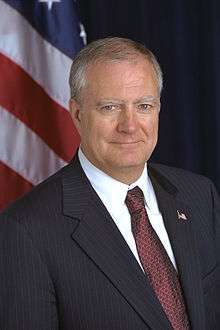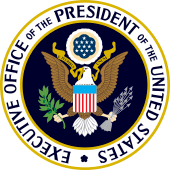Office of Science and Technology Policy
 | |
| Agency overview | |
|---|---|
| Formed | May 11, 1976 |
| Preceding agency |
|
| Headquarters |
Eisenhower Executive Office Building 725 17th Street, Washington, D.C., U.S. |
| Employees | 45 |
| Agency executive |
|
| Parent agency | Executive Office of the President |
| Website | WhiteHouse.gov/OSTP |
The Office of Science and Technology Policy (OSTP) is a department of the United States government, part of the Executive Office of the President (EOP), established by United States Congress on May 11, 1976, with a broad mandate to advise the President on the effects of science and technology on domestic and international affairs.
The director of this office is colloquially known as the President's Science Advisor. The position has been vacant since President Donald Trump took office, along with a number of other leadership positions in the agency.[1] In August 2018, meteorologist Kelvin Droegemeier was nominated for the position.[2]
History
_A.jpg)
President Richard M. Nixon eliminated the President's Science Advisory Committee after his second Science Advisor, Edward E. David Jr., resigned in 1973, rather than appointing a replacement. The United States Congress then established the OSTP in 1976 with a broad mandate to advise the President and others within the Executive Office of the President on the effects of science and technology on domestic and international affairs. The 1976 Act also authorizes OSTP to lead inter-agency efforts to develop and to implement sound science and technology policies and budgets and to work with the private sector, state and local governments, the science and higher education communities, and other nations toward this end.
Under President Donald Trump, OSTP's staff dropped from 135 to 45 people.[3] As of March 29, 2018, the OSTP director position remains vacant, the longest vacancy for the position since the office's founding.[4] Kelvin Droegemeier, an atmospheric scientist who currently serves as the vice president of research at the University of Oklahoma, was nominated for the position on August 1, 2018.[5]
Mission
The OSTP's mission is set out in the National Science and Technology Policy, Organization, and Priorities Act of 1976 (Pub. L. 94-282). The act calls for the OSTP to serve as a source of scientific and technological analysis and judgment for the President with respect to major policies, plans, and programs of the federal government.
It further authorizes the OSTP to:
- Advise the President and others within the Executive Office of the President on the impacts of science and technology on domestic and international affairs;
- Lead an inter-agency effort to develop and implement sound science and technology policies and budgets;
- Work with the private sector to ensure Federal investments in science and technology contribute to economic prosperity, environmental quality, and national security;
- Build strong partnerships among Federal, State, and local governments, other countries, and the scientific community;
- Evaluate the scale, quality, and effectiveness of the Federal effort in science and technology.[6]
The OSTP handles a broad range of scientific and technological issues within the Executive Office of the President. It participates in a multitude of White House Policy Coordinating Committees (PCC) that are tasked with developing policies for the federal government and are populated by senior officials from cabinet and independent agencies. The OSTP has approximately 45 staff members, most of whom are experienced scientists functioning as assistant directors or policy analysts.
Key staff
- Director for the Office of Science and Technology Policy: Vacant
- Deputy Director for the Office of Science and Technology Policy: Vacant
- Associate Director for Technology: Vacant
- Principal Assistant Director for Science: Vacant
- Assistant Director for Social, Behavioral and Economic Sciences: Vacant
- Associate Director for Science: Vacant
- Chief Technology Officer of the United States: Vacant
- Deputy Chief Technology Officer: Michael Kratsios[7]
- Associate Director for National Security & International Affairs: Vacant
- Associate Director for Energy & Environment: Vacant
Directors
| No. | Portrait | Name | President | Term |
|---|---|---|---|---|
| 1 | H. Guyford Stever | Gerald Ford | 1976–1977 | |
| 2 |  |
Frank Press | Jimmy Carter | 1977–1981 |
| Benjamin Huberman (acting) | Ronald Reagan | 1981 | ||
| 3 |  |
George A. Keyworth, II | 1981–1985 | |
| John P. McTague (acting) | 1986 | |||
| Richard G. Johnson (acting) | 1986 | |||
| 4 |  |
William Robert Graham | 1986–1989 | |
| Thomas P. Rona (acting) | 1989 | |||
| William G. Wells (acting) | George H. W. Bush | 1989 | ||
| 5 | D. Allan Bromley | 1989–1993 | ||
| 6 | John H. Gibbons | Bill Clinton | 1993–1998 | |
 |
Kerri-Ann Jones (acting) | 1998 | ||
| 7 |  |
Neal F. Lane | 1998–2001 | |
 |
Rosina Bierbaum (acting) | George W. Bush | 2001 | |
| Clifford Gabriel (acting) | 2001 | |||
| 8 |  |
John H. Marburger III | 2001–2009 | |
| 9 |  |
John Holdren | Barack Obama | 2009–2017 |
 |
Kelvin Droegemeier (nominee) | Donald Trump | 2018–present |
See also
References
- ↑ Lapowsky, Issie (January 20, 2018). "The lasting impacts of Trump's first year". Wired.
- ↑ Reardon, Sara; Witze, Alexandra (31 July 2018). "The wait is over: Trump taps meteorologist as White House science adviser". Nature.
- ↑ Alemany, Jacqueline (November 21, 2017). "Donald Trump's science office is a ghost town". CBS.
- ↑ Aldhouse, Peter (January 18, 2017). "Trump's war on science isn't what you think". CBS.
- ↑ https://www.vox.com/2018/8/1/17639314/trump-science-adviser-kelvin-droegemeier-ostp
- ↑ "About OSTP: Department Organization". OSTP.gov. Office of Science and Technology Policy. Retrieved 2008-06-21.
- ↑ "Trump's White House science office still small and waiting for leadership". Science | AAAS. 2017-07-11. Retrieved 2017-08-19.
- ↑ "Previous Science Advisors (1973–2009)". White House – via National Archives and Records Administration.
